Rory Dall’s Sister’s Lament
Cumh Peathar Ruari
Originally published in the Folk Harp Journal Fall 2012
This beautiful melody was first published under the title Cumh Peathar Ruari — Rory Dall’s Sister’s Lament by Daniel Dow circa 1778, in A Collection of Ancient Scots Music for the violin, harpsichord or German flute: Never before printed consisting of ports, salutations, marches and pibrachs & c.
(One must appreciate the titles like this, so typical of books in days of old).
Just who, precisely, this man Rory Dall
was is uncertain. Most definitely a man, as Rory is a familiar version of the name Roderick
. Dall is Gaelic for blind, so we know that whoever this man Rory was, he was blind. Speculation is that he was the Scottish harper Roderick Morison (circa 1656-1713) who served as the harper to Clan MacLeod for a good part of his career (and almost certainly played wire-strung harp). Dow’s collection is a Scottish collection and this harper’s dates make it possible that he was the composer. We don't know if Rory had a sister who died before he did, for whom he might have composed this lament, but that’s not to say he did not have one.[1] Or, it could be that he composed a lament on his sister’s behalf, perhaps for a death or loss that affected her.
There is another complication regarding the composer. There is a tune that is very similar to the lament on pages 23 and 24 in the Straloch Lute Manuscript (1627-1629) which was clearly written before the Scottish harper Rory was born and thus could not possibly have been written by him. The suggestion is sometimes made that this tune, which is labeled merely A Port
and is given no attribution, was written by another harper, an Irishman, because his name was also Rory and he was also blind. This harper is the Irish Rory Dall O’Cahain, and his dates of c.1570-1650 make it quite possible that he composed the tune in the Straloch Manuscript (MS). However, the name of the composer comes from a completely different and much later source (the Dow) so it is a leap of logic to assign it back to the earlier source.
There is also the question of whether or not these two, the Lament and the Port, really are the same tune. I suggest that either the earlier version served as an inspiration for the latter (and not necessarily in direct line) or that these are two different versions of an even earlier tune that is now lost. One seems to be a more complete version, while the other seems to have suffered in transmission somewhere along the line, much like a poem suffers as it moves through the children’s game of Chinese Whispers
or Telephone.
Examining the two tunes side-by-side
Are these the same tune? Let’s take a look at some of the similarities and some of the differences.
Before we begin the comparison, please note that there are two obvious mistakes in the Straloch Port, and the corrections I chose to make have been noted in the music. The Straloch transcription has been transposed up a perfect fifth so to have the same tonal center as the Dow for ease of comparison. Also, all phrase markings in both the Port and the Lament are my own, to guide the comparison that follows.
Both tunes present in 3/4 time, three beats to a measure with the quarter note taking the beat. Dow is explicit in this, while the Straloch MS simply leaves this implied. There are barlines in the Straloch, and all but one bar has three beats in it, but there is no time signature given.
Looking at the first phrase of the melody, contained in the first three bars of the tune (reproduced below, designated by the Roman Numeral I), we see that the first two bars are quite different, but the distinctive octave drop at the end of the phrase draws our attention to a broad similarity between the two.
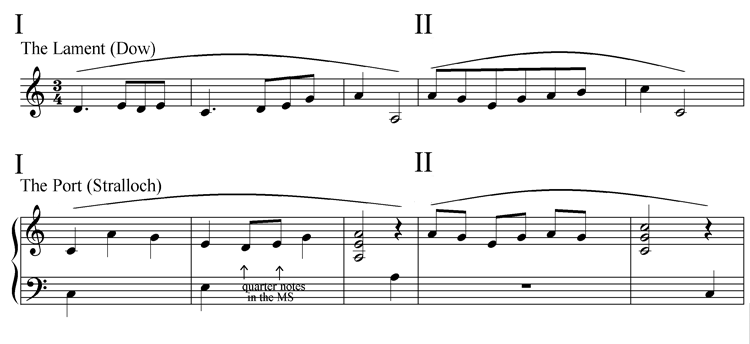
The second phrase (Roman Numeral II above) has a similar shape with a run of six eighth notes (quavers) in the first bar and again the distinctive octave drop at the end, though in the Straloch’s Port that leap is a double octave. One wonders if this might be an error, or merely an exaggeration of the leap.
At this point, our neat comparison ends. It is very obvious that the first section of the Port is significantly shorter than the first section of the Lament from Dow’s collection, 8 bars and 12 bars, respectively. (This first section is comprised of the above example, roman numerals I and II, and the below example labeled III). The structure in the Lament is phrases of 3–2–3–4 bars, while the Port follows a structure of phrase lengths of 3–2–3 bars. So, on first glance, it might appear that the Port has merely missed out the final 4–bar phrase of the Lament. But more careful comparison would seem to show that the third phrase of the Lament (III) is completely missing from the Port and also missing is the first bar of the Lament’s final phrase. In other words, the final 3–bar phrase of the Port is actually just the last three bars of the final 4–bar phrase of the Lament. This makes quite a difference to the melody.
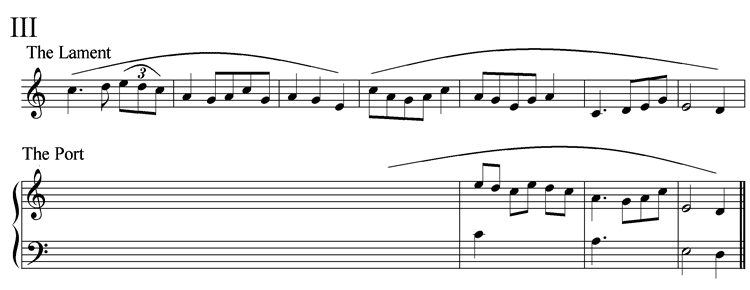
One of the distinguishing characteristics of the Lament is the rhythm of a dotted-quarter note followed by three eighth notes. In the Port, this pattern appears only two times. So it is not a surprise that the two versions continue along different paths in the second section. Here (IV) we see the Port marching up the range to a high point of E, similar to the Lament, but in a different rhythm and with a smaller downward interval in each musical figure; up two steps, down one step as compared to the Lament dropping a third and then struggling up four steps to recover to the same level. The Port does have a reoccurance of that interesting double-octave drop, something the Lament never uses.
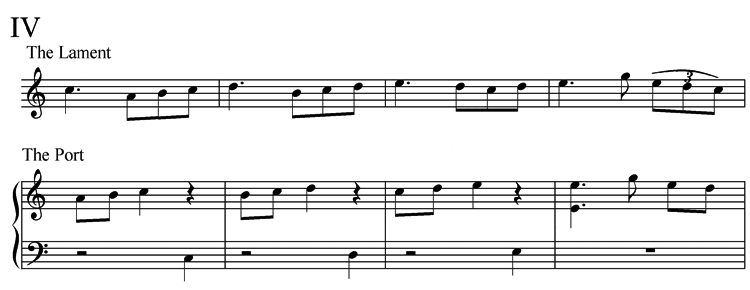
In the next phrase (V) Dow’s Lament is immensely more musical, with a melodic climax at the high A. The Port from the Straloch is almost boring. The first two bars from this section in the Port, the very part that is so interesting in the Lament, repeat the exact same notes and rhythm. One wonders again, could this be an error? Yet, again, the similarity of the two melodies evinces itself at the end of the phrase, as the final two bars almost exactly mirror each other.
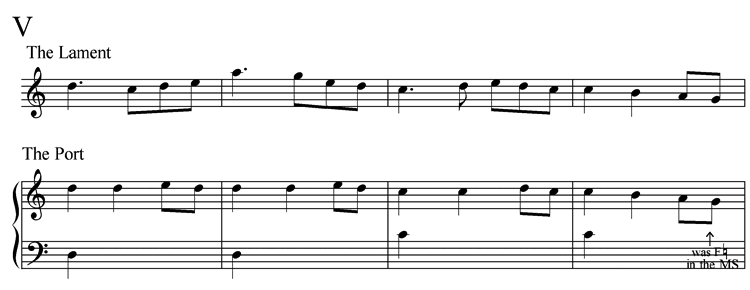
In the final phrase (VI) — though it may be two phrases, depending on your interpretation — the melody of both tunes tracks in general the same. Passing tones differ, there are more ornamental flourishes present in the Lament than in the Port, rhythms diverge, but again they come together at the very end.
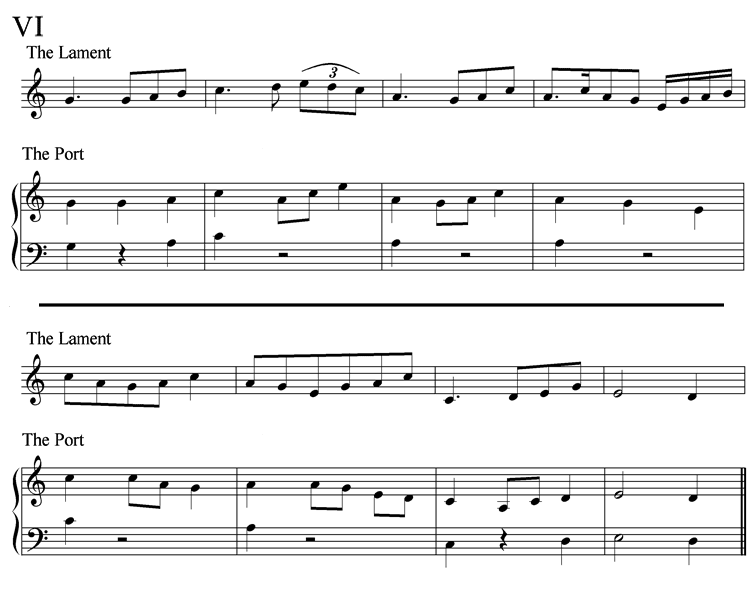
Perhaps most impressive as a distinction is the pattern of a dotted-quarter note followed by three eight notes rhythm discussed previously. In the Lament, that rhythm appears 10 times, with a further 4 appearances if we allow for the ornamented version of the rhythm, being those bars that have the triplet figure. This rhythm appears in the Port merely twice.
In studying these two pieces side–by–side, we are challenged to remember that the Straloch Port is the earlier version. We expect the earlier version of a work to be more complete, and the later version to have forgotten or weaker sections; yet here it appears that the Lament as Dow presents it is the more complete work and the Straloch is perhaps an inferior echo of an original.
With 150 years separating these two collections, much could happen. It is possible that the lutenist who scribed the Straloch did indeed remember only part of a common, earlier tune. Or could be that this was the complete tune in the area where he practiced his art.
There is also a chance that a harper named Rory desired to write a piece of music and this tune was in his memory. He may have created from it more than it was.
A modern example may suffice to make the point. George Harrison composed a tune entitled My Sweet Lord, about the desire of a man to better understand his relationship with God. He had in his memory a tune that had the rhythm and structure he needed, perfect for his lyric, though unfortunately for him the tune had a declared composer, and this all happened post 1777.[2] He was successfully sued for copyright infringement, but the point of the matter for our purposes is that he took a song about a girl with a crush on a boy and made a song about the spiritual life of a man: different song.
Whatever path the work Cumha Peathar Ruari took to eventually appear in Daniel Dow’s Collection, it did get there and got there first. This is the earliest example we have of this tune bearing this title in any collection. It is indeed quite different from the Straloch’s A Port. For myself, I consider them two different melodies and when I play the Lament for Rory Dall’s Sister, it is Cumha Peathar Ruari that sings from my harp.

photo by Brandon Andrusic
Endnotes:
[1] William Matheson, An Clarsair Dall — The Blind Harper; The Songs of Roderick Morison and His Music, The Scottish Gaelic Texts Society (Edinburgh, 1970) p 167.
[2] It was not until 1777 that copyright laws in Great Britain included the same protection of published music as was afforded to the written word. See John Small, J.C. Bach Goes to Law. The Musical Times, Vol. 126, No 1711 (Sep., 1985), pp. 526–529
Some editorial changes were made to this article, mainly to suit a new layout as an internet website rather than a journal article. However, in the original publication there was an error in the examples of the Port above, both bar 3 and 5 (see the first example). The half-note and quarter note were "stacked" in the print publication and should have been placed "in time" as they are above.